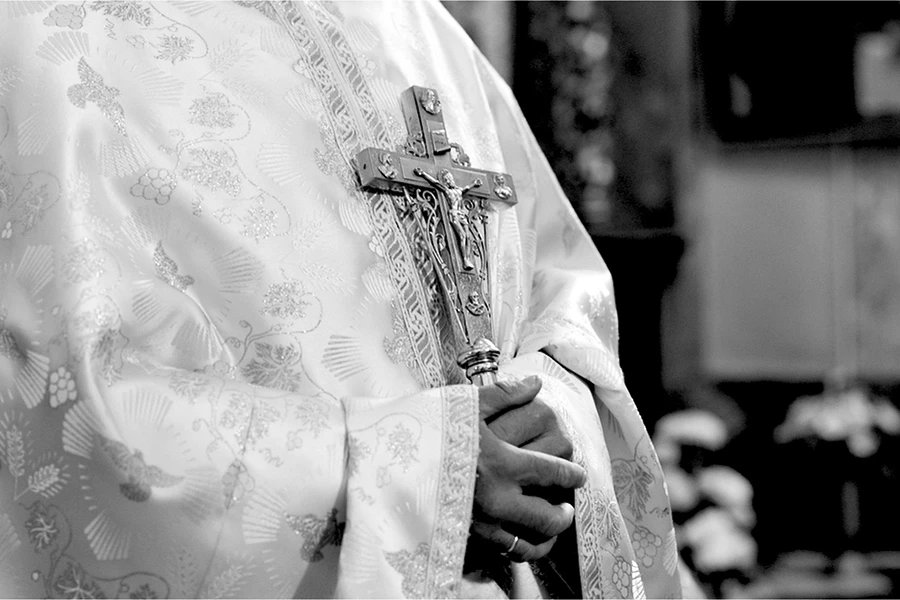
Denver, Colo., Sep 28, 2017 / 06:26 am (CNA/EWTN News).- Dr. George Isajiw, the grandson of a slain Ukrainian priest, always knew that his grandfather was martyred by the Soviet secret police, amidst the chaos of World War II.
“Of course everybody…considered him a martyr, considered him a saint, in the family,” Isajiw told CNA on Sept. 9.
On June 26, 1941, 67-year-old Father Nicolas Konrad and a 34-year-old parish cantor, Volodymyr Pryjma, had set out on a sick call.
They knew the risks. Nikita Khrushchev, then Stalin’s envoy to Ukraine, had given the order to shoot priests amidst a retreat of Soviet forces across Ukraine.
The two men had taken the sacraments to a parishioner and were returning home to their church in the western Ukrainian village of Stradch. They were detained by two agents of the Cheka, the Soviet secret police. Then they were taken out into the woods and shot.
Both men were among the Greek-Catholic martyrs beatified by Pope John Paul II in June 2001. Pryjma left behind three children, while Father Konrad, a married priest in the Eastern Catholic tradition, left behind four grown children and a widow, Antonina.
Isajiw knew those details of his family story. But what Father Konrad’s grandson didn’t know was a secret that his grandmother had kept close.
When the beatification of Fr. Konrad was announced in 2000, Isajiw’s sister remembered something special about her grandmother’s dress.
“We examined it carefully, looked in the pockets, and there’s the bullet holes,” said Isajiw, a physician in private practice in Lansdowne, Pa.
Dr. Isajiw is a past president of the Catholic Medical Association. He displayed the dress this month, at a booth at the association’s educational conference in Denver.
“That’s his cassock. The cassock he was wearing when he was killed,” he continued. “My grandmother took that cassock. She cut out the front panel and the back panel, because the bullet hole is in the front and the exit wound is in the back.”
His grandmother had repurposed the cassock into a dress and covered the bullet holes with pockets.
“She made a dress out of it for herself, so when she put her hands in her pockets she could feel the bullet holes,” said the doctor.
After the war, his grandmother had lived with a Catholic family in Bavaria before emigrating to join her surviving family in Pennsylvania, where she lived until her death in 1955.
She had worn the dress the rest of her days.
“We took it with us to the beatification,” said Isajiw.
In 1941, both Fr. Konrad and Antonina had decided not to leave Ukraine, even though family members could secure them emigration papers to Germany. Fr. Konrad had been an academic all his life. His assignment in Stradtch would be his first parish role.
Half of the residents were illiterate. Antonina began teaching the children to read and write.
A Soviet military installation was about a mile from the village church.
On June 22, 1941, Blessed Nicholas was leading a procession for the Feast of Corpus Christi when the military base came under attack from the invading Germans.
“He took everyone back into the church and gave his famous sermon: ‘Be not afraid,’ Little knowing that four days later he’d be dead,” the priest’s grandson recounted.
Isajiw summarized one account of the homily:
“He said all our lives are changed. The war is started. Who knows what will happen? But we’re not going to change. We’ll keep doing what we’re doing, taking care of ourselves, taking care of our families, not panicking and not changing our lifestyle, trusting in God.”
Isajiw, who never met his grandfather, said it felt very special to be the grandson of a martyr.
“I feel closer to him now, after studying all this,” he said. “His heroic virtue was he already knew priests were being targeted, and he still went with the sacraments.”
Blessed Nicholas Konrad is known as a patron of students and his active canonization cause is promoted by many at the Ukrainian Catholic University in Lviv. There are pilgrimages to the site of his execution, and the priests at Stradtch hold retreats. He is often petitioned by those seeking relief from addiction to drugs, alcohol or smoking.
And thanks to Antonina, his cassock is well-preserved, now a holy relic of his martyrdom.
If you value the news and views Catholic World Report provides, please consider donating to support our efforts. Your contribution will help us continue to make CWR available to all readers worldwide for free, without a subscription. Thank you for your generosity!
Click here for more information on donating to CWR. Click here to sign up for our newsletter.




Leave a Reply